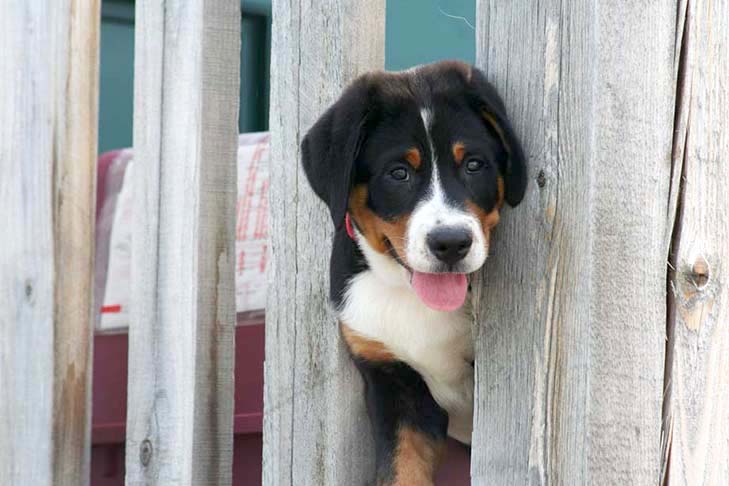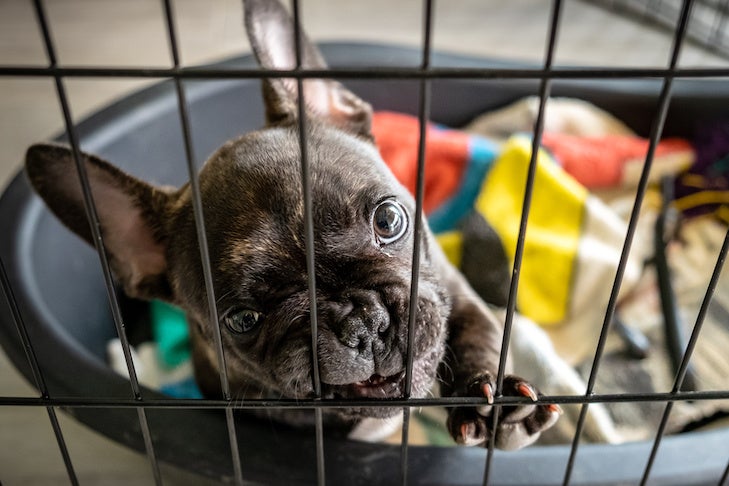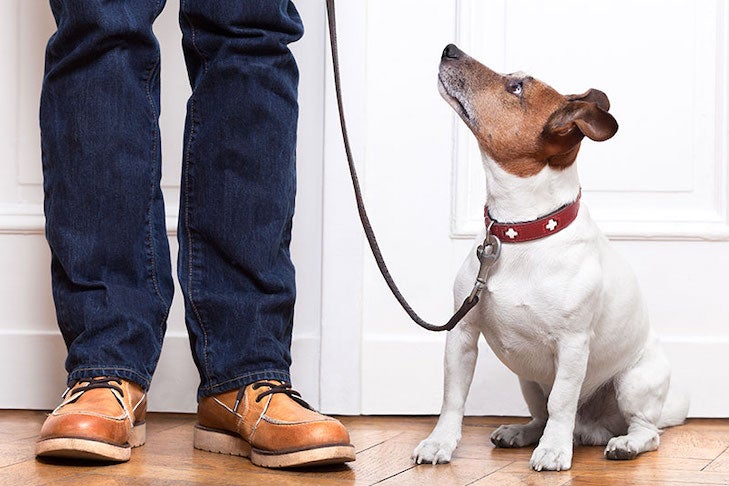
AKC is a participant in affiliate advertising programs designed to provide a means for sites to earn advertising fees by advertising and linking to akc.org. If you purchase a product through this article, we may receive a portion of the sale.
Keeping your dog out of certain rooms can prevent problem behaviors, such as counter-surfing in the kitchen. Alternatively, there are times you might want to keep your dog within a certain space, like an unfenced yard. Whether you’re keeping your dog inside one area or outside another, you can accomplish this with boundary training.
The Benefits of Boundary Training
Boundary training teaches your dog where they can and cannot go. Whether it’s a single room or your entire backyard, your dog learns the boundaries of their space. There are other ways to keep your dog in or out, but training your dog to make good choices about where they spend their time will free you from constant supervision and management.
Boundary training can also be part of teaching household rules and manners. After all, if your dog never sets foot in your bedroom, they will never learn to sleep on your bed. Boundary training is also important for safety, particularly outside. Your dog shouldn’t be free to escape the yard and roam into a busy roadway or encounter wild animals.

Management During Boundary Training
Boundary training requires consistency. You can’t let your dog in the kitchen when you’re having your coffee but expect them to stay outside the room when you’re cooking. So, while you’re teaching boundaries, it’s essential you don’t allow your dog to cross them. That means you need to manage your dog’s behavior until the training is complete.

Inside the house, baby gates can block doorways or halls. Or you can place your dog in a crate or exercise pen when you can’t watch them. Outdoors, the best plan is to accompany your dog and keep them on leash until boundary training is complete. That way they will never learn they can wander off and they will never be inadvertently rewarded by the environment outside your yard.
Boundary Training Indoors
For indoor boundary training, you will need your dog’s leash and some treats your dog loves. The goal is for your dog to decide it’s more rewarding to stay outside of the room than to come in and explore it. The following steps will help your dog learn to stay outside a particular room.
- Step toward the boundary/doorway and stop just before entering the room. Keep the leash short to ensure your dog stops with you.
- When your dog comes to a stop, immediately reward them. Then, turn and walk away from the doorway. Repeat this process until your dog anticipates what is expected and stops on their own.
- Now you can continue one step into the forbidden room. Your dog should stop outside the doorway as before. If they try to follow you into the room, block them. Return to step 2 for more repetitions before trying step 3 again. If your dog stops on their side of the door, immediately return to them and reward.
- Begin to walk further and further into the forbidden room before returning to your dog with a reward.
- Now you can begin to add duration and distractions. But only work on one at a time. First, ask your dog to wait longer and longer on their side of the boundary before you return with the reward. Then, when they’ve mastered that, you can start to add distractions. Use minor distractions at first, then build to more exciting ones.

It will take many weeks to build in all three Ds (distance, duration, and distraction). And even once your dog understands, there may still be the odd distraction that proves to be too much. If you anticipate something will lure your dog over the boundary, like a turkey roasting in the oven or visiting guests, then use management techniques until the temptation has passed.
Boundary Training Outdoors
You can teach boundaries outdoors in the same way by simply walking your dog to the edge and rewarding them for staying on the correct side. However, the outside world is incredibly distracting, so the use of flags and clicker training can really help build your dog’s understanding.
You will need a long lead, a clicker, and enough flags to space them out every 8 to 10 feet along the perimeter of the boundary. You will also need your dog’s absolute favorite treat, such as chunks of chicken or steak. You’re competing with the outside environment, so use something special your dog only gets during this exercise to really reinforce the message. These steps will train an outdoor boundary:
1. In the house, show your dog a flag. Click and treat if they show any interest. If your dog already knows how to target, ask them to target the flag. The goal is for your dog to touch the flag with their nose, then return to you for their reward. As your dog improves, add distance so they must travel to the flag and then walk back to you for their treat.
2. After a week or two of indoor practice, place the flags outside along the boundary. Then, with your dog on a 15-to-20-foot leash, walk around the yard. If you practiced enough indoors, your dog should happily go to the flags and then return to you to earn a reward. Don’t click when your dog targets the flag. Instead, click when they turn back toward you. This reinforces leaving the edge of the boundary rather than approaching it.
3. Practice at least once or twice a day for several months. As your dog gets better and better, increase the length of the lead so they need to walk all the way back to the middle of the yard or, better yet, the porch or back door before receiving their treat.
4. Next, add distractions to the other side of the boundary. Start small, and then add more excitement.
5. Finally, allow your dog in the yard off-leash. But continue to supervise and click and treat any flag targeting.
6. If your dog goes over the boundary at any time, do not punish them. Instead, bring them back into the yard and reward their return.
7. If you wish to remove the flags, wait until your dog has been reliable for at least 6 months.

Be sure to keep the yard exciting for your dog. Provide toys and play lots of fun games together within the boundaries. This will reinforce that it’s better inside the perimeter than out. But there will be times when a distraction proves to be too much for your dog and they leave the area. Therefore, it’s also important to train a solid recall so you can get your dog back easily.


